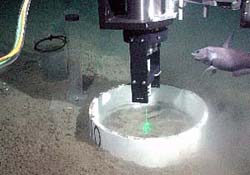Researchers explore the ocean floor with rare instrument

A fish on the ocean floor off California gazes at a sight no human has seen first-hand: a modified Raman spectrometer gathering data on a carbon dioxide sample. Jill Pasteris, Ph.D., Washington University professor of earth and planetary sciences, heads a Washington University group collaborating with researchers at the Monterey Bay Area Research Institute (MBARI) to determine the feasibility of storing the greenhouse gas carbon dioxide on the ocean floor. The Raman spectrometer is the first-ever deployed on the ocean floor. <br>Courtesy of Monterey Bay Area Research Institute
Trapping carbon dioxide in an icy age
In collaboration with oceanographers from the Monterey Bay Aquarium Research Institute (MBARI), a team of geologists at Washington University in St. Louis is using a rare instrument on the ocean floor just west of California. One of their earliest projects was to see if it’s possible to capture carbon dioxide from the atmosphere and store it on the ocean floor. The research is supported by the Department of Energy.
The geologists, headed by Jill Pasteris, Ph.D., professor of earth and planetary sciences in Arts & Sciences, and their MBARI colleagues are the first to deploy a Raman spectrometer on the ocean floor. The instrument combines a portable focusing lens with a potent laser to examine minerals, gases and liquids – even seawater itself. Pasteris’ group and their MBARI colleagues are using Raman spectroscopy to see what carbon dioxide in either a pure liquid or a complex solid phase will do on the sea floor. They also are examining the feasibility of synthetically trapping carbon dioxide in solids called clathrate hydrates, ice-like solids that form a cage around gas molecules, such as methane, trapping them and storing them. Such solids occur naturally on the ocean floor. The hope is that someday carbon dioxide can be trapped in a similar way.
“It’s a remotely controlled laboratory on the ocean floor manipulated by a robot and controlled from the research ship above,” explained Pasteris. “The Raman signals so far are telling us that we can track the carbon dioxide and tell the different types, gas or liquid, and the spectra also can distinguish clathrate hydrates.
“The ocean floor is still a mysterious place. You can’t get scientists directly on the floor, so you either send them down in miniature subs or operate remotely as the MBARI group does. Ultimately, we want to get more expertise on the mineralogy of the sea floor, and we believe the Raman spectrometer is the best thing going to give on-the-spot analysis and identification.”
Pasteris explained her collaborative research at the Geological Society of America annual meeting held Nov. 2-5 in Seattle.
Pasteris and her colleagues John Freeman, Ph.D., and Brigitte Wopenka, Ph.D., Washington University research scientists, are collaborators with oceanographers and engineers at MBARI. In the past they have analyzed the kind of sulfur that unusual bacteria oxidize on the ocean floor for MBARI scientists, again using their specialty, Raman spectroscopy. In the carbon sequestration research, MBARI scientists have dismantled the Raman spectrometer system and placed its components in three pressure-resistant cylinders connected by fiber optic cables. A robotic arm controlled from the research ship manipulates the probe head containing the laser. The laser excites various effects in samples, including what is called the Raman effect. The same lens system used to focus the laser then captures backscattered radiation and routes it to the cylinder with the electronics instrument for analysis.
“The emergence of Global Positioning Systems and remotely operated vehicles such as MBARI employs make the use of our instrumentation in extreme environments more and more feasible,” Pasteris said. “We expect to get valuable data on the growth of carbon dioxide clathrate hydrate, the formation of secondary solid and dissolved species, the formation of carbon dioxide-saturated boundary layers in ocean water, and the dissolution of sea-floor minerals, among other information, in future deployments.”
She said that hydrothermal vents on the sea floor – a possible site for the origin of life on Earth — and their attendant bacterial colonies are possible future candidates for DORISS, the deep-ocean Raman in-situ spectrometer system. MBARI scientists are studying ways of downsizing the Raman instrument package so that other instruments can piggyback together with it on the robotic vehicles that are sent to the sea floor.
Media Contact
More Information:
http://news-info.wustl.edu/tips/page/normal/553.htmlAll latest news from the category: Earth Sciences
Earth Sciences (also referred to as Geosciences), which deals with basic issues surrounding our planet, plays a vital role in the area of energy and raw materials supply.
Earth Sciences comprises subjects such as geology, geography, geological informatics, paleontology, mineralogy, petrography, crystallography, geophysics, geodesy, glaciology, cartography, photogrammetry, meteorology and seismology, early-warning systems, earthquake research and polar research.
Newest articles

An Endless Loop: How Some Bacteria Evolve Along With the Seasons
The longest natural metagenome time series ever collected, with microbes, reveals a startling evolutionary pattern on repeat. A Microbial “Groundhog Year” in Lake Mendota Like Bill Murray in the movie…

Witness Groundbreaking Research on Achilles Tendon Recovery
Achilles tendon injuries are common but challenging to monitor during recovery due to the limitations of current imaging techniques. Researchers, led by Associate Professor Zeng Nan from the International Graduate…

Why Prevention Is Better Than Cure—A Novel Approach to Infectious Disease Outbreaks
Researchers have come up with a new way to identify more infectious variants of viruses or bacteria that start spreading in humans – including those causing flu, COVID, whooping cough…



